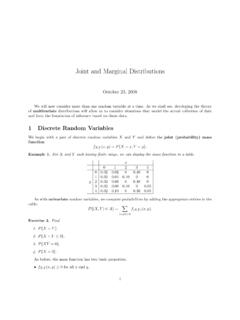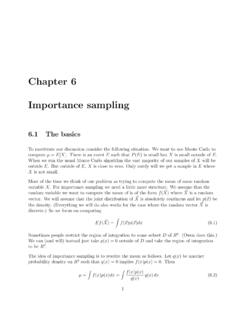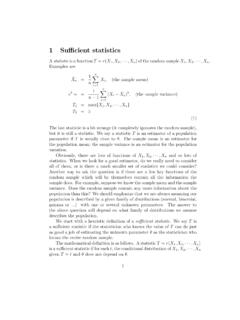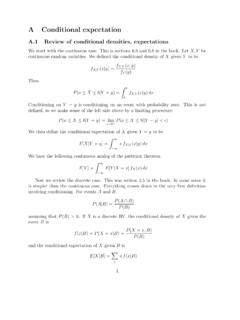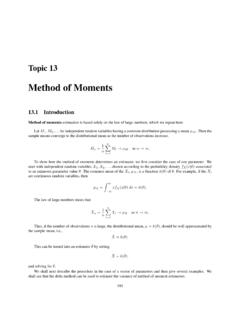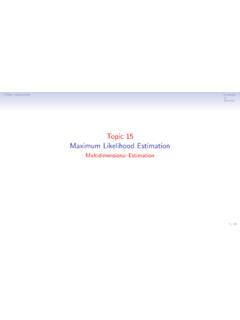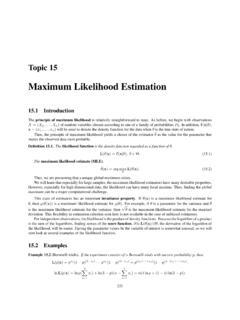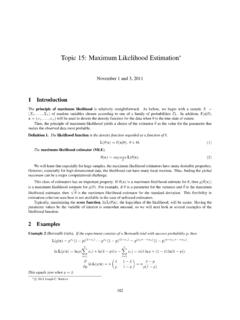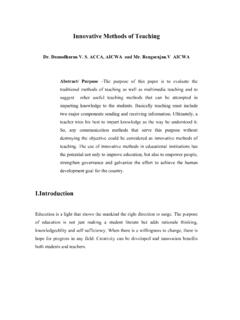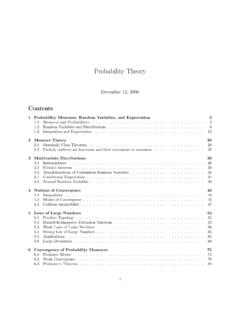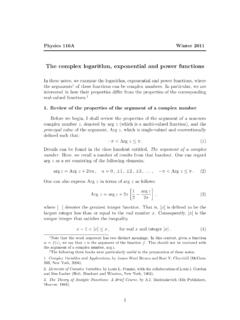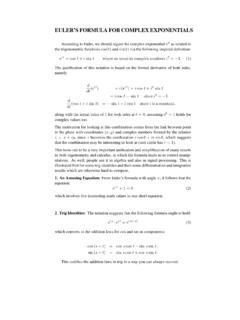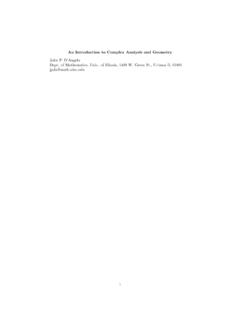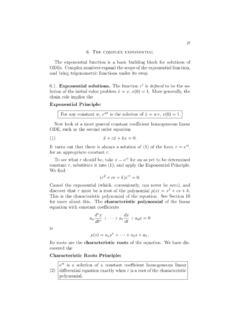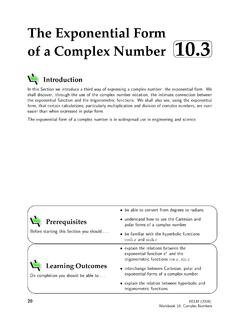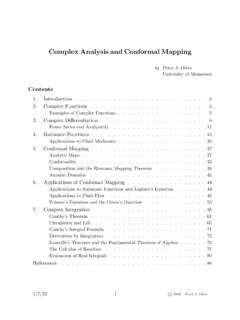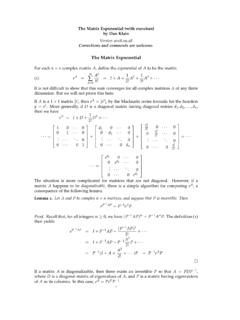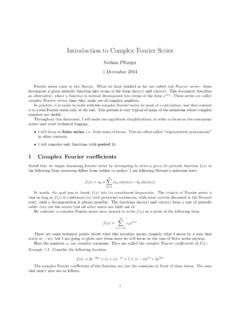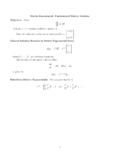Transcription of Complex integration - University of Arizona
1 Chapter 1 Complex Complex number + |13+4i|. the cube roots of are some identities for Complex conjugate. Which ones need correc-tion?z+w= z+ w,z w= z w,zw= z w,z/w= z/ w. Make suitablecorrections, perhaps changing an equality to an are some identities for absolute value. Which ones need correction?|z+w|=|z|+|w|,|z w|=|z| |w|,|zw|=|z||w|,|z/w|=|z|/|w|. Makesuitable corrections, perhaps changing an equality to an log(z) so that <=log(z) . Discuss the identitieselog(z)=zand log(ew) = is the power series of log(1 +z) aboutz= 0? What is the radius ofconvergence of this power series? is the power series of cos(z) aboutz= 0? What is its radius ofconvergence? How many solutions are there of cos(z) =wwith <<z .12 CHAPTER 1. Complex Complex Closed and exact formsIn the following a region will refer to an open subset of the plane. A differentialformp dx+q dyis said to be closed in a regionRif throughout the region q x= p y.
2 ( )It is said to be exact in a regionRif there is a functionhdefined on the regionwithdh=p dx+q dy.( )Theorem. An exact form is converse is not true. Consider, for instance, the plane minus the form ( y dx+x dy)/(x2+y2) is not exact in this region. It is, however,exact in the plane minus the negative axis. In this region y dx+x dyx2+y2=d ,( )where /2< < s theorem. IfSis a bounded region with oriented boundary S, then Sp dx+q dy= S( q x p y)dx dy.( )Consider a regionRand an oriented curveCinR. ThenC 0 (Cishomologous to 0) inRmeans that there is a bounded regionSsuch thatSandits oriented boundary Sare contained inRsuch that S= Ifp dx+q dyis closed in some regionR, and ifC 0 inR, then Cp dx+q dy= 0.( )IfCis an oriented curve, then Cis the oriented curve with the oppositeorientation. The sumC1+C2of two oriented curves is obtained by followingone curve and then the other. The differenceC1 C2is defined by followingone curve and then the other in the reverse a regionRand two oriented curvesC1andC2inR.
3 ThenC1 C2(C1is homologous toC2) inRmeans thatC1 C2 0 Ifp dx+q dyis closed in some regionR, and ifC1 C2inR,then C1p dx+q dy= C2p dx+q dy.( ) Complex Cauchy-Riemann equationsWritez=x+iy. Define partial differential operators z= x+1i y( )and z= x 1i y( )The justification for this definition is the following. Every polynomial inx, ymay be written as a polynomial inz, z, and conversely. Then for each term insuch a polynomial zzm zn=mzm 1 zn( )and zzm zn=zmn zn 1.( )Letw=u+ivbe a functionf(z) ofz=x+iy. Suppose that this satisfiesthe system of partial differential equations w z= 0.( )In this case we say thatf(z) is an analytic function ofzin this region. Explicitly (u+iv) x (u+iv) iy= 0.( )This gives the Cauchy-Riemann equations u x= v y( )and v x= u y.( ) The Cauchy integral theoremConsider an analytic functionw=f(z) and the differential formw dz=f(z)dz= (u+iv) (dx+idy) = (u dx v dy) +i(v dx+u dy).
4 ( )According to the Cauchy-Riemann equations, this is a closed (Cauchy integral theorem) Iff(z) is analytic in a regionR, and ifC 0 inR, then Cf(z)dz= 0.( )4 CHAPTER 1. Complex INTEGRATIONE xample: Consider the differential formzmdzfor integerm6= 1. Whenm 0 this is defined in the entire Complex plane; whenm <0 it is defined inthe punctured plane (the plane with 0 removed). It is exact, sincezmdz=1m+ 1dzm+1.( )On the other hand, the differential formdz/zis closed but not exact in thepunctured Polar representationThe exponential function is defined byexp(z) =ez= n=0znn!.( )It is easy to check thatex+iy=exeiy=ex(cos(y) +isin(y)).( )Sometimes it is useful to represent a Complex number in the polar represen-tationz=x+iy=r(cos( ) +isin( )).( )This can also be writtenz=rei .( )From this we derivedz=dx+i dy=dr ei +riei d .( )This may also be writtendzz=drr+i d .( )Notice that this does not say thatdz/zis exact in the punctured plane.
5 Thereason is that the angle is not defined in this region. Howeverdz/zis exactin a cut plane, that is, a plane that excludes some line running from the originto (0) be a circle of radiusrcentered at 0. We conclude that C(0)f(z)dz= 2 0f(z)z i d .( )In particular, C(0)1zdz= 2 0i d = 2 i.( )By a change of variable, we conclude that for a circleC(z) of radiusrcenteredatzwe have C(z)1 zd = 2 i.( ) Complex integration AND RESIDUE Branch cutsRemember thatdzz=drr+i d ( )is exact in a cut plane. Thereforedzz=dlog(z)( )in a cut plane,log(z) = log(r) +i ( )Two convenient choices are 0< <2 (cut along the positive axis and < < (cut along the negative axis).In the same way one can define such functions as z= exp(12log(z)).( )Again one must make a convention about the Complex integration and residue The Cauchy integral formulaTheorem. (Cauchy integral formula) Letf( ) be analytic in a regionR. LetC 0 inR, so thatC= S, whereSis a bounded region contained inR.)
6 Letzbe a point inS. Thenf(z) =12 i Cf( ) zd .( )Proof: LetC (z) be a small circle aboutz. LetR be the regionRwith thepointzremoved. ThenC C (z) inR . It follows that12 i Cf( ) zd =12 i C (z)f( ) zd .( )It follows that12 i Cf( ) zd f(z) =12 i C (z)f( ) f(z) zd .( )Consider an arbitrary >0. The functionf( ) is continuous at =z. Thereforethere is a so small that for onC (z) the absolute value|f( ) f(z)| . Thenthe integral on the right hand side has integral with absolute value bounded by12 2 0 d = .( )Therefore the left hand side has absolute value bounded by . Since is arbitrary,the left hand side is 1. Complex The residue calculusSay thatf(z) has an isolated singularity atz0. LetC (z0) be a circle aboutz0that contains no other singularity. Then the residue off(z) atz0is the integralres(z0) =12 i C (z0)f(z)dz.( )Theorem. (Residue Theorem) Say thatC 0 inR, so thatC= Swiththe bounded regionScontained inR. Suppose thatf(z) is analytic inRexceptfor isolated singularitiesz1.
7 , zkinS. Then Cf(z)dz= 2 ik j=1res(zj).( )Proof: LetR beRwith the singularities omitted. Consider small circlesC1, .. , Ckaround these singularities such thatC C1+ +CkinR . Applythe Cauchy integral theorem toC C1 .. (z) =g(z)/(z z0) withg(z) analytic nearz0andg(z0)6= 0, thenf(z)is said to have a pole of order 1 Iff(z) =g(z)/(z z0) has a pole of order 1, then its residue atthat pole isres(z0) =g(z0) = limz z0(z z0)f(z).( )Proof. By the Cauchy integral formula for each sufficiently small circleCaboutz0the functiong(z) satisfiesg(z0) =12 i Cg(z)z z0d =12 i Cf(z)dz.( )This is the EstimatesRecall that for Complex numbers we have|zw|=|z||w|and|z/w|=|z|/|w|.Furtherm ore, we have||z| |w|| |z w| |z|+|w|.( )When|z|>|w|this allows us to estimate1|z w| 1|z| |w|.( )Finally, we have|ez|=e<z.( ) A residue calculationConsider the task of computing the integral e ikx1x2+ 1dx( )wherekis real. This is the Fourier transform of a function that is inL2andalso inL1.
8 The idea is to use the analytic functionf(z) =e ikz1z2+ 1.( )The first thing is to analyze the singularities of this function. There are polesatz= i. Furthermore, there is an essential singularity atz= .First look at the case whenk 0. The essential singularity of the exponen-tial function has the remarkable feature that for=z 0 the absolute value ofe ikzis bounded by one. This suggests looking at a closed oriented curveCainthe upper half plane. TakeCato run along thexaxis from atoaand thenalong the semicirclez=aei from = 0 to = . Ifa >1 there is a singularityatz=iinside the curve. So the residue is the value ofg(z) =e ikz/(z+i) atz=i, that is,g(i) =ek/(2i). By the residue theorem Cae ikz1z2+ 1dz= ek( )for eacha > leta . The contribution from the semicircle is bounded by 01a2 1a d = aa2 1.( )We conclude that fork 0 e ikx1x2+ 1dx= ek.( )Next look at the case whenk 0. In this case we could look at an orientedcurve in the lower half plane.
9 The integral runs fromato aand then arounda semicircle in the lower half plane. The residue atz= iise k/( 2i). Bythe residue theorem, the integral is e k. We conclude that for all realk e ikx1x2+ 1dx= e |k|.( ) 01 x(4 +x2)dxby contour integration . Show all steps, including estimation of integralsthat vanish in the limit of large 1. Complex the following problemsf(z) is analytic in some region. We say thatf(z) has a root of multiplicitymatz0iff(z) = (z z0)mh(z), whereh(z)is analytic withh(z0)6= 0. Find the residue off (z)/f(z) at such thatf(z) has several roots inside the contourC. Evaluate12 i Cf (z)f(z) thatf(z) =a0+a1z+a2z2+ +anznis a polynomial. Furthermore, suppose thatCis a contour surroundingthe origin on which|akzk|>|f(z) akzk|.Show that on this contourf(z) =akzkg(z)where|g(z) 1|<1on the contour. Use the result of the previous problem to show that thenumber of roots (counting multiplicity) the number of roots (counting multiplicity) ofz6+3z5+1 inside theunit More residue Jordan s lemmaJordan s lemma says that forb >0 we have1 0e bsin( )d 1b.
10 ( )To prove it, it is sufficient to estimate twice the integral over the intervalfrom 0 to /2. On this interval use the inequality (2/ ) sin( ). This gives2 20e 2b / d =1b(1 e b) 1b.( ) MORE RESIDUE A more delicate residue calculationConsider the task of computing the integral e ikx1x idx( )wherekis real. This is the Fourier transform of a function that is inL2but notinL1. The idea is to use the analytic functionf(z) =e ikz1z i.( )The first thing is to analyze the singularities of this function. There is a poleatz=i. Furthermore, there is an essential singularity atz= .First look at the case whenk <0. TakeCato run along thexaxis from atoaand then along the semicirclez=aei in the upper half plane from = 0to = . Ifa >1 there is a singularity atz=iinside the curve. So the residueis the value ofg(z) =e ikzatz=i, that is,g(i) =ek. By the residue theorem Cae ikz1z idz= 2 iek( )for eacha > leta . The contribution from the semicircle is bounded usingJordan s lemma: 0ekasin( )1a 1a d 1 kaaa 1( )We conclude that fork <0 e ikx1x idx= 2 iek.
